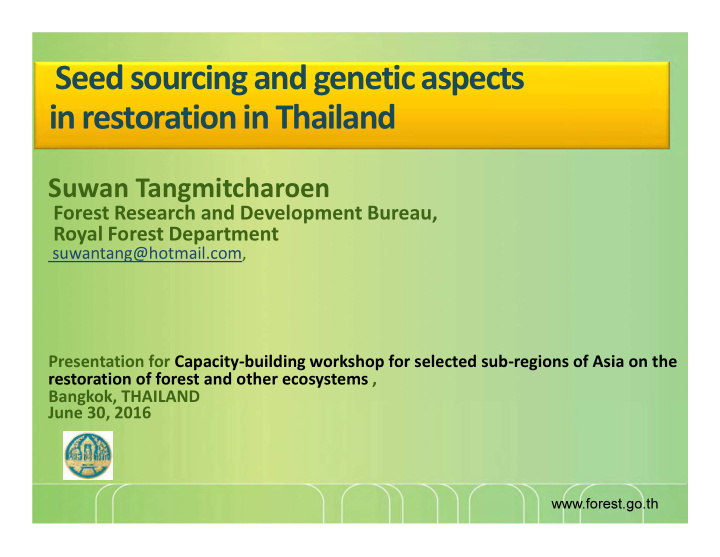



Seed sourcing andgenetic aspects in restoration in Thailand Suwan Tangmitcharoen Forest Research and Development Bureau, Royal Forest Department suwantang@hotmail.com, Presentation for Capacity-building workshop for selected sub-regions of Asia on the restoration of forest and other ecosystems , Bangkok, THAILAND June 30, 2016 www.forest.go.th
OUTLINE OF THE PRESENTATION Introduction Genetic diversity of some important native species Seed source and Classification Lesson learned from experiences Approaches under Climate Changes: Options for future management
Forest cover in Thailand 32.62% of the country area 102,285,400 sq.km. North 23.97% 52.60% North-east 22.18% Central East 15.02% 32.86% South Year 2014
Major Forest Conservation Areas in Thailand in 2014 0.05% 0.04% 1.39% 4.10% National Park Wildlife Sanctuary Non-Hunting Area Forest Park 35.18% Botanical Garden 59.25% Arboretum Source: Department of National Park ,Wildlife and Plant Conservation (2014)
The target is to bring the forest cover to 40% of the country area Protected Forest Economic Forest 25% of the country area 15% of the country area FOREST AREA
Forest Biodiversity of Thailand > 2,000 species Number of species of Flora & Fauna 8% of the world flora & fauna endemic only to Flora : 10,000 THAILAND Fern : 658 Orchid: 1,140 Mammals: 302 Birds : 928 Reptiles: 350 Amphibians: 137 Fresh Water Fishes : 720 Marine Fishes : 2,100 Source: Thailand National Report on the Implementation of convention on Biological Diversity ( Report on 2009 )
Top Priority Species on Forest Genetic Resources of Thailand Dalbergia cochinchinensis Afzelia xylocarpa Dipterocarpus alatus Hopea odorata Pterocarpus macrocarpus Tectona grandis Sour: *Chantragoon et al., (2012)
Genetic Conservation First Era: tree introduction, species trail, botanical garden) Second Era: tree breeding (provenance trails, progeny test) Third Era: Linked with breeding & biotechnology – DNA Molecular) (Soekotjo 2001)
Genetic Diversity of SiammeseRosewood ( Dalbergia cochinchinensis) Geographic distribution can be categorized into 2 groups Yooyuen(2012) Soonhuae(1994)
Teak Seed Zone (GenecologicalZones) Graudal et al. 1997 Tectona grandis
Geographical grouping of teak populations in Thailand based on the results of the DNA structure analysis identified 6 regions and 1 admixture zone Saichat Pongkrawee & Hugo Volkeart, In preparation
Sources of Seeds Plantation Natural (Improve genetic materials ) • Difficult access • Easy access • Difficult seed • Easy collection collection • Cheaper • More expensive seed collection
1.3 การจําแนกแหล่งเมล็ดพันธุ์ไม้ป ่ า(ต่อ) Seed Source Classification 1. Seed Orchard Quality 2. Provenance Seed Stand 3. Seed Production Area 4. Selected Stand 5. Identified Stand 6. Seed Collection Zone
Seed Source Classification 1. SEED COLLECTION ZONE 2. IDENTIFIED STAND 3. SELECTED STAND 4. SEED PRODUCTION AREA 5. PROVENANCE SEED STAND 6. SEED ORCHARD
Development of Seed Source Acacia auriculiformis AFTER Tree Improvement BEFORE Tree Improvement Seed orchard
Teak Seed Orchard chantaburi chiengrai khonkaen Lampang
Seed Orchard of 33 year-old Pinus caribaea Chiengmai
Plus tree (selected tree, superior tree)
Plus tree Section and Seed Source Survey for Siamese Rose wood ( Dalbergia cochinchinesis )
Plus tree Section and Seed Source Survey for Siamese Rose wood ( Dalbergia cochinchinesis )
Some challenged seeding technique (applied recently) Paramotor Shooting seed ball difficult terrain Photo taken:18 June 2016
Lesson learned from experience o Seed source from (improved) plantation is better than from natural forest. o Breeding strategies of (each) species should be developed. o Biotechnology help to enhance effectiveness and speed up of improved seed source establishment. o Seed exchange is necessary for effective genetic test.
Approaches under Climate Changes: Options for future management o Develop specific breeding program (well adapted to changing environment) o Ensuring quantity and quality of seed sources o Establish static conservation (Cryopreservation, cold storage freeze preservation of vegetative part) to preserve improved genetic materials
Development of cryopreservation techniques for long-term in vitro conservation of Siamese Rosewood ( Dalbergia cochinchinensis Pierre) Shoots from tissue culture Keep the shoots in Liquid nitrogen (-196 celcius) RFD
Thank you for your attention
Recommend
More recommend